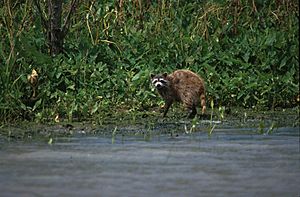Delta National Wildlife Refuge facts for kids
Quick facts for kids Delta National Wildlife Refuge |
|
|---|---|
|
IUCN Category IV (Habitat/Species Management Area)
|
|
| Location | Plaquemines Parish, Louisiana |
| Nearest city | Venice, Louisiana |
| Area | 49,000 acres (200 km2) |
| Established | 1935 |
| Governing body | U.S. Fish and Wildlife Service |
| Website | Delta National Wildlife Refuge |
The Delta National Wildlife Refuge is a special place for wildlife. It's about 10 miles (16 km) east of Venice, Louisiana, right by the Mississippi River. This area was created naturally. In 1862, the Mississippi River broke through its banks. This happened about 100 miles (160 km) south of New Orleans, Louisiana.
The refuge is huge, covering about 48,000 acres (194 km²). It was bought in 1935 to protect birds, especially ducks and geese that spend winter there. You can only reach the refuge by boat.
Contents
Amazing Animals and Their Homes
The Delta National Wildlife Refuge is home to many different animals. Thousands of ducks and geese visit in winter. They find lots of food in the delta. Many other birds also visit the refuge. Their numbers are highest during spring and fall, when they are migrating.
Lots of wading birds build nests here. Thousands of shorebirds can be seen on the muddy areas near the water. Many furry animals and game animals live here all year. The marshes and waterways are home to many kinds of fish and shellfish.
Shorebirds and Raptors
Thousands of shorebirds use the refuge in winter. They also stop here to rest during their long migrations. Some common shorebirds you might see include yellowlegs, dowitchers, and sandpipers. You might also spot killdeer and willets.
Birds of prey, called raptors, are often seen at the refuge. The most common ones are American kestrels, northern harriers, red-tailed hawks, and turkey vultures. Other raptors like Cooper's hawks and merlins have also been seen. Ospreys are common visitors in winter.
Other Wildlife
Many songbirds use the refuge as a resting spot during their spring and fall migrations. Deer are often seen along the riverbanks and in the marshes. Swamp rabbits are also common throughout the refuge. Many furry animals live here, with the nutria being the most common.
The marshes and waterways are full of different fish. You can find saltwater fish like speckled trout, redfish, flounder, blue crabs, and shrimp. In the freshwater areas, you might find catfish, largemouth bass, and different kinds of sunfish. The refuge is a very important place where young fish, both freshwater and saltwater, can grow.
Marsh Habitat
The refuge's marsh is a special type of wetland. It has two main zones: fresh marsh and brackish marsh. The fresh marsh is closer to the main rivers. The brackish marsh is closer to the Gulf of Mexico. About 60% of the refuge is fresh marsh.
The marsh has fertile soil and shallow water. This makes it a great home for many plants and animals. It also offers fun activities like fishing and wildlife watching. The refuge protects many plant and animal species. This includes endangered or threatened species like the American alligator, brown pelican, Arctic peregrine falcon, and piping plover.
Hundreds of thousands of ducks and geese have been counted here during peak times.
Hurricanes and the Refuge
The Delta National Wildlife Refuge has been hit by strong storms, like Hurricane Katrina. These storms can change the refuge a lot. Marsh and beach areas can be washed away. Trees can be blown down or damaged. Saltwater can flood the area, which stresses the plants. Sometimes, oil spills and grounded boats also affect the refuge.
Camping is no longer allowed at the Delta National Wildlife Refuge.
Oil Spill Impact
The refuge was also affected by the oil spill from the Deepwater Horizon explosion. This oil spill was very large. It reached the refuge and caused damage to the environment.
Images for kids




